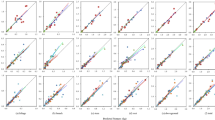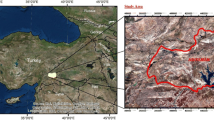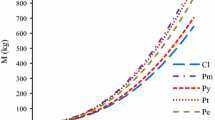Abstract
Generic equations are proposed for stem, branch and foliage biomass of individual trees in even-aged pure stands of Cryptomeria japonica, Chamaecyparis obtusa and Larix kaempferi. Biomass data was collected from a total of 1,016 individual trees from 247 stands throughout Japan, and five regression models were assessed by root mean square error, mean bias, fit index (FI), and AIC. The results show that a power equation using diameter at breast height (dbh) and height is the most suitable for all species and components. This equation is more accurate than the familiar power equation that uses ‘dbh2 height’, and it expresses the greater volume of branch and foliage mass of trees with a lower height/diameter ratio. A power equation using dbh is more reasonable for models with dbh as the only independent variable and more accurate than a power equation using ‘dbh2 height’ for estimating branch and foliage mass. Estimating error for branch and foliage mass is larger than that for stem mass, but the entire aboveground biomass can be estimated with an error of less than 19%, except in the case of small trees with dbh less than 10 cm.


Similar content being viewed by others

Notes
Titles of “in Japanese” articles are our tentative translation from the original Japanese title.
References
Titles of “in Japanese” articles are our tentative translation from the original Japanese title.
Eamus D, McGuinness K, Burrows W (2000) Review of allometric relationships for estimating woody biomass for Queensland, the Northern Territory and Western Australia, National Carbon Accounting System Technical Report 5a. Australian Greenhouse Office, Canberra
Fukuda M, Iehara T, Matsumoto M (2003) Carbon stock estimates for sugi and hinoki forests in Japan. For Ecol Manage 184:1–16
IPCC (2003) Good practice guidance for land use, land-use change and forestry. IPCC National Greenhouse Gas Inventories Programme, Hayama
Jenkins JC, Chojnacky DC, Heath LS, Birdsey RA (2003) National-scale biomass estimators for United States tree species. For Sci 49:12–35
Kira T, Shidei T (1967) Primary production and turnover of organic matter in different forest ecosystems of the western Pacific. Jpn J Ecol 17:70–87
Komiyama A (1999) Measuring forest toward the future: Broad-leaved secondary forest. Shinrin-kagaku 27:41–43 (in Japanese)
Kvålseth TO (1985) Cautionary note about R 2. Am Stat 39:279–285
Migita C, Tanouchi H, Utsugi H, Nakamura T (2001) Analysis of factors to prescribe allometric coefficient using Japanese cypress and cedar. Trans Jpn For Soc 112:85 (in Japanese)
Ministry of the Environment of Japan (2008) National Greenhouse Gas Inventory Report of Japan, May 2008. National Institute for Environmental Studies, Tsukuba
Muukkonen P (2007) Generalized allometric volume and biomass equations for some tree species in Europe. Eur J For Res 126:157–166
Nagumo H, Minowa M (1990) Forest mensuration. Chikyusha, Tokyo (in Japanese)
Nilsen P, Strand LT (2008) Thinning intensity effects on carbon and nitrogen stores and fluxes in a Norway spruce (Picea abies (L.) Karst.) stand after 33 years. For Ecol Manage 256:201–208
Okuno T (ed) (1992) Applied statistics handbook. Yokendo, Tokyo (in Japanese)
Peichl M, Arain MA (2007) Allometry and partitioning of above- and below-ground tree biomass in an age-sequence of white pine forests. For Ecol Manage 253:68–80
R Development Core Team (2008) R: a language and environment for statistical computing. http://www.R-project.org
Sato T (1973) Material production of land plant community I a. Kyoritsu Shuppan, Tokyo (in Japanese)
Schumacher FX, Hall FDS (1933) Logarithmic expression of timber-tree volume. J Agric Res 47:719–734
Somogyi Z, Cienciala E, Mäkipää R, Muukkonen P, Lehtonen A, Weiss P (2007) Indirect methods of large-scale forest biomass estimation. Eur J For Res 126:197–207
Suzuki G (1995) Introduction to statistical analysis with information criterion. Kodansha Scientific, Tokyo (in Japanese)
Tanouchi H, Utsugi H (2004) National evaluation of forest site productivity considering growth environment characteristics. In: FFPRI Project Report 3: advancement of evaluation of the CO2 income and expenditure in forests and oceans. Forest and Forest Products Research Institute, Tsukuba, pp 24–28 (in Japanese)
Tanouchi H, Utsugi H, Shiono K (2004) Allometry of major tree species in Japan: can a common coefficient be found? Abstr Jpn For Soc Kanto Branch 56:31 (in Japanese)
Yamamoto W (1918) Stem volume and breast height form factor table for Pinus densiflora. Bull Imperial For Exp Stat Jpn 16:147–164 (in Japanese)
Yoda K (1971) Forest ecology. Tsukiji Shokan, Tokyo (in Japanese)
Zianis D, Muukkonen P, Mäkipää R, Mencuccini M (2005) Biomass and stem volume equations for tree species in Europe. Silva Fenn Monogr 4:1–63
Acknowledgments
We thank the many researchers at the prefectural forestry research institutes who greatly contribute to forest carbon sink projects. We also express our appreciation for the cooperation of private forest owners, Regional and District Forest Offices, and the Research, Extension, and Environment Policy Division of the Forestry Agency of Japan. Miki Fukuda, Satoshi Ishibashi, Tomohiro Nishizono, Hiroshi Kondo, Kunihiro Tanaka, Eiji Kodani (FFPRI), Iwao Noda (Japan International Research Center for Agricultural Sciences), Yoshio Awaya (Gifu University) and Masahiro Amano (Waseda University) collaborated with us on the national forest project. We also thank the anonymous reviewers for their careful reading of this article and insightful comments. Part of this study was supported by the Global Environment Research Coordination System of the Ministry of Environment of Japan as a research project on the Influence of Environmental Changes and Forest Management Practices on CO2 Sequestration of Conifer Plantations (FY2004–2008).
Author information
Authors and Affiliations
Corresponding author
About this article
Cite this article
Hosoda, K., Iehara, T. Aboveground biomass equations for individual trees of Cryptomeria japonica, Chamaecyparis obtusa and Larix kaempferi in Japan. J For Res 15, 299–306 (2010). https://doi.org/10.1007/s10310-010-0192-y
Received:
Accepted:
Published:
Issue Date:
DOI: https://doi.org/10.1007/s10310-010-0192-y



